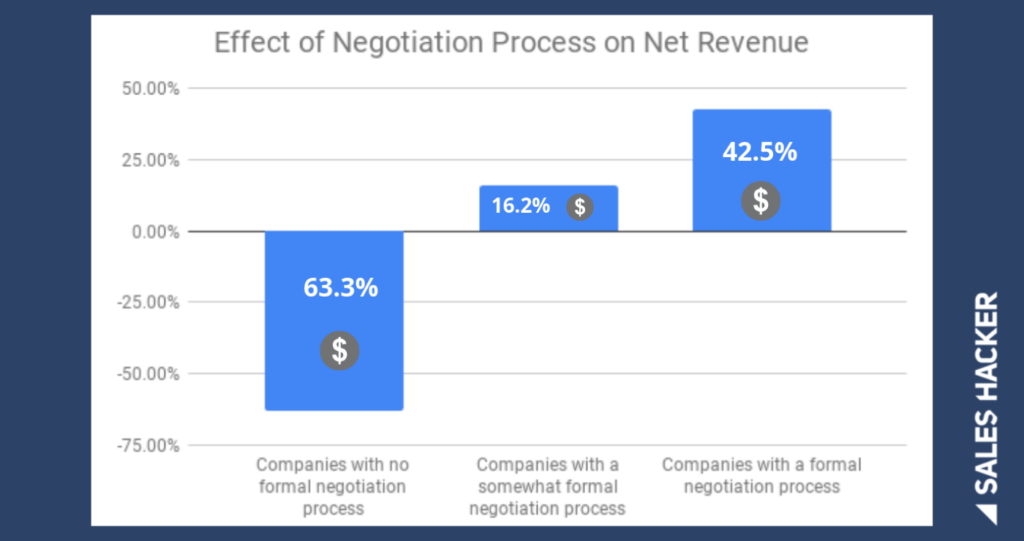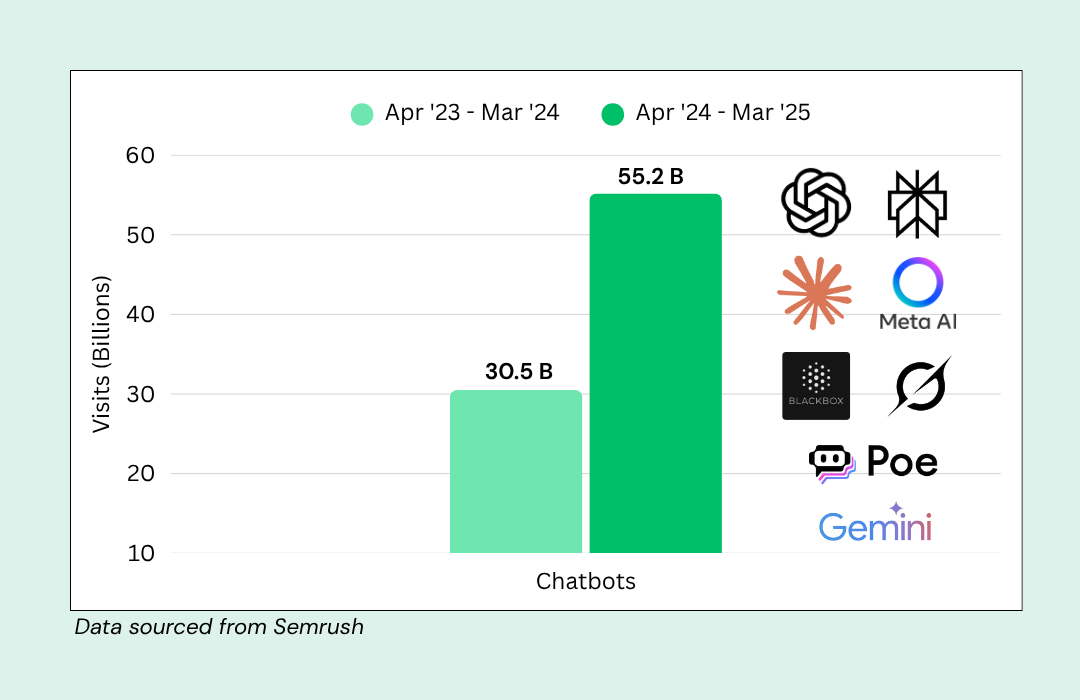Here’s the scene: you’ve worked hard (really hard) to get a deal to the “verbal yes” stage. Then, your prospect drops this on you:
“We like you, but you need to do something about that price.”
Or this:
“We’re ready to go, but I just need to make little revision to the contract…”
Think about how you’d respond. What would you say that could help you win at this point in a negotiation?
Average salespeople cave at this point. They’ll take what they can get, so long as they close the deal. And buyers know this! They take advantage of salespeople’s fear of losing the deal.
Excellent salespeople overcome their fear of saying no and use key negotiation phrases that protect margins and still get the deal done.
By the end of this post, you will know:
- Why you need a formal negotiation process
- Two main tactics buyers use in negotiations
- Exactly what phrases to use to win a negotiation, and when to use them
- How to overcome a fear of saying “no”
Let’s get started.
Why You Need a Formal Negotiation Process
Simply put, salespeople are the last line of defense of every business’ margins.
But if you need more reason than that, here are some findings from a two-year study of sales negotiations from Huthwaite International:
- Companies with no formal negotiation process had a 63.3% decrease in net income
- Companies with a somewhat formal negotiation process had a 16.2% increase in net income
- Companies with a formal negotiation process experienced a 42.5% increase in net income!

Clearly, sticking to a formal negotiation process is worth your time.
But the same study also found that 80% of the participating companies had no formal negotiation process. And 75% of the companies had no negotiation planning tools.
They weren’t helping their salespeople plan for negotiations! The deal could be for $76 million, yet the salespeople would still spend just 30 minutes to an hour preparing to negotiate.
That won’t cut it. When it comes to negotiating, lack of preparation has major financial repercussions.
Buyers seem to be far more aware of this than salespeople. And they use two very common tactics to win negotiations:
- The Squeeze
- The Nibble
The Squeeze: When the Buyer Asks for a Price Reduction at the Last Minute
Buyers will use The Squeeze in negotiations time and time again. It’s a surefire way to get untrained salespeople to decrease the price.
In simple terms, The Squeeze is where the buyer nurtures the salesperson, tells them just how much they want to work together, and gives them hope.
Then, at the last minute, they say something that puts all that hope at risk. For example:
“We like you, but you need to do something about that price.”
Don’t Say This: “Where do you need us to be?”
As a salesperson, this is the worst phrase you could use. It sends the message that there is some flexibility in your pricing, which gives the buyer an in! You also risk losing credibility.
For example, if you agree to a 10% discount without putting up much of a fight, the buyer may wonder why it was so easy. Could something be wrong with the product or service?
Other Phrases to Avoid: “list price”, “standard price”, or “typical price”
I’m a brand ambassador for Gong.io. They did some research and found that when a sales rep uses phrases like “list price,” “standard price,” or “typical price” at any point during the deal, the sales cycle is 19% longer.
This is because these terms needlessly give the buyer hope of flexibility. Don’t set that precedent.
How to Respond to The Squeeze
Responding to The Squeeze can be intimidating. But I’ve got six steps for you
1. Be Confident
Be confident when facing The Squeeze! You’ve come far in this deal, and your buyer just said they like you. Use that.
What you should do:
- Be Brief! Top sales performers use about 102 words to explain their pricing, while the bottom sales performers use roughly 144 words. Brevity exudes confidence.
- Speak in the first person. By using “I” rather than “we” phrases, you’ll humanize yourself and enjoy more success in your negotiations.
- Use phrases like “approved price,” which implies a higher power than you when it comes to setting the price.
- Pause after the pricing component of your presentation. The top sales performers pause for an average of 2.1 seconds, signaling rock-solid confidence.
2. Use “The Clinger”
How do you stand out from your competition? When the buyer says, “We like you, but you’ve got to do something about that price,” cling to the number one differentiator that you uncovered during your discovery call.
The clinger is the top thing that makes you different in your buyer’s eyes. Any mention of a discount should trigger a pivot right back to this hot-button. Cling to it with your life!
What you should do:
- Stand tall with your pricing and explain what separates you from the competition. Is it your 24/7 customer support? The uniqueness of your product? Or possibly it’s a creative reframe that you developed highlighting an unrecognized or misunderstood pain point.
- In addition to requests for a discount, you should also use your clinger phrase whenever a buyer makes mention of your competition. Have the courage to reiterate your clinger multiple times in the conversation.
3. Buy Time
You may feel awkward during the negotiation process, but avoid rushing through it. Instead, when the buyer asks for a lower price, take that as an opportunity to get more information.
Here’s an example of what a top-performing salesperson should say:
“I understand that pricing is something we need to address. But before we do, I’d like to make sure I completely understand your needs—that way we’ll know we’re doing everything we can to make this deal as valuable as possible for you. Is that all right?”
What you should do:
- Find out what’s important to the buyer. To put them at ease, ask for permission to explore their needs further.
- Ask the buyer open-ended questions. Get them talking. The more they talk, the more you’ll learn about what is truly important to them. Begin each question with one of these three phrases to ensure elaborative answers:
- “Can you help me understand…”
- “Talk to me about…”
- “Walk me through…”
- Have the courage to pry into their personal affairs. What they don’t tell you reveals a lot! Every question you ask is like a mini negotiation. Questions are the equivalent to demands, and answers are the equivalent to offers. The bigger your question, the bigger the answer. Begin your prying question with this phrase to increase the likelihood of an answer:
- “I invite you to say ‘no’ to this question, but [INSERT QUESTION]”
- As Dr. Chester Karrass used to say, “Ask questions like a country boy.” Don’t be too perfect, and polished. People are more likely to answer your questions if they feel comfortable and not intimidated. Be Columbo, not Tom Brady.
4. Use the “If-You” Rule
This countermeasure emphasizes perceived value. It allows salespeople to concede without really having to concede.
Here’s an analogy: Say you go to a deli or a Chinese restaurant, and you pay for your meal at the counter. Often, there’s a bowl of candy by the register. People tend to take more than one piece when it’s free.
However, if the restaurant were to charge 25 cents for every piece of candy, people would be less likely to grab a handful of sweets. Suddenly, they perceive the candy as being of value, and they become more cautious in their decision-making.
Similarly, salespeople should avoid simply giving their product away without asking for something of value in return.
What you should do:
- Trade with the buyer for something of value when they request a lower price. Consider agreeing to a 5% discount, but only if the buyer doubles the order quantity or purchases from a second product line.
- Only concede if you get something in return of greater value to you! If the buyer declines the opportunity to trade, guess what? Your price goes right back to where it started.
5. Trial Balloon
This is an advanced tactic for skilled negotiators. When the buyer says, “We like you, but you’ve got to do something about that price,” consider this response:
“Can you help me understand what you’re looking to achieve with a 20% reduction in price?”
What you should do:
- Consider giving them a discount if they provide lots of information and detail. Then, you can trust what they’re saying, and you know they’re being sincere. If you do concede, remember the “If-You” rule (why not get something back in return, even if it’s an I owe you one).
- Avoid lowering your price if the buyer stumbles over their answer. If they lack evidence in support of their request, stand your ground. They were just digging for a deal.
6. Considered Response
When the buyer asks for a lower price, take some time to think. Let a few minutes go by, make it seem like you’re mulling over their request, and tactfully say “no.”
What you should do:
- Tell the buyer you need a minute. Then, pull out a calculator or a pad of paper, and spend some time looking like you’re trying to make the numbers work.
- Make eye contact with the buyer, and gently tell them that you can’t accommodate their ask. They’ll be more satisfied with your “no” in this case because at least they tried.
The Nibble: When a Buyer Keeps Asking for Lots of Little Things
Like The Squeeze, The Nibble preys on your reluctance to take risks. The Nibble is when the buyer asks for small concessions at the very end of the negotiation process.
They might request more time to pay. They might ask for free shipping, an extra round of revisions, or better terms.
Regardless of the specific ask, professional “nibblers” will make these requests over and over and over again.
Don’t Say This: “We can make that work!”
Salespeople need to understand the cost of the little things they give away. They also need to understand how these costs impact their margin and overall operating profit. They need to care!
How to Respond to The Nibble:
These smaller negotiations can feel less intimidating to respond to. Still, it’s well worth preparing some of these six phrases and tactics to avoid giving up too much ground.
1. Take It or Leave It
If the buyer asks for free shipping or a reduced rate, your response might be as simple as a tactful ‘no’. For example, you could say:
“It’s against company policy to offer free shipping.”
It’s highly unlikely that the buyer will walk away at this point. Rather, they’ll likely shrug their shoulders and move forward with the deal anyway.
| Related: How to Walk Away From a Business Deal Without Burning Bridges
What you should do:
- Take a firm position. Tell the buyer that as a rule, you can’t accommodate what they’re requesting.
- Use legalese phrases like “policy,” “procedure,” and “regulations” to discourage the buyer from pressing the issue. These phrases will imply that your position is non-negotiable.
2. “Are You Kidding?”
This approach is ideal for one-off negotiations. If you’re hoping to enter a long-term partnership with the buyer, think twice before using this strategy. You may come off a little abrasive.
What you should do:
- When the buyer asks for a 3% discount, make eye contact and say, “Are you kidding?”
- Speak with conviction. When most people nibble, they don’t feel great about it. Your response will remind them of that.
3. If-You Rule
This is the same tactic we discussed in “The Squeeze”. It works just as well in response to nibbling buyers. Essentially, you are turning their small Nibbles into small opportunities for you.
4. Inject Time
This negotiation tactic is surprisingly effective. If the buyer wants you to throw in a little extra something for free, or if they request a discount, let them know they’ll have to wait a few extra weeks for the deal to go through if they want to proceed with their ask.
Here’s how you could phrase a response:
“Not a problem, we can do that for you BUT because we’re now changing the structure of this deal, I’m going to need to get our agreement revised by legal. It shouldn’t take more than a few weeks.”
What you should do:
- Stand firm. Let the buyer know it’ll take quite a bit of time to give them what they want.
- Keep in mind that most people don’t want to wait a few weeks for something insignificant like a change in terms or free shipping. And if they do, then maybe it’s worth making the concession.
5. Limited Authority
Similar to injecting time, you can dissuade the buyer from pushing their request by letting them know it’ll add time to the sale process.
The next time a buyer requests free shipping (or something similarly insignificant), think about using a simple phrase like:
“I don’t have the authority to change the contract terms.”
What you should do:
- Don’t back down. If the buyer then asks to talk to someone who does have the authority to update your contract, let them know you’ll gladly put them in touch—but it might take a while for the person to get back to them.
- Be patient while the buyer contemplates their response. Chances are they won’t want to wait, and they’ll agree to the current terms.
6. Nurture
This is more of a preventative measure than an active countermeasure to The Nibble. That said, it’s equally important.
No matter how frustrated you are, aim to be nice and nurturing to nibbling buyers. Never be angry, or show that you’re upset. This will help preserve your confidence and your professional relationship.
What you should do:
- Take a deep breath if you’re mad or irritated. Then, refer to the countermeasures outlined above.
- Let the buyer know you understand where they’re coming from. It may feel like they’re trying to take advantage of you, but they might not be conscious of that.
Now let’s sum up what we’ve learned…
You’ve just read a summary of buyer tactics and phrases salespeople should avoid in negotiations, as well as phrases you can use strategically in your next deal.
In closing, here are three takeaways:
- Take the time to invest in negotiation training, practice and preparation. Research shows your bottom line will thank you.
- Brevity is your friend. Be concise when you discuss your pricing during a negotiation, use “I” phrases whenever possible. Pause after you finish talking.
- Saying “no” may feel uncomfortable. However, by understanding different negotiation styles and by using the phrases in this article as a point of reference, you can do so with confidence.
Now tell me what you think. Which parts of the article surprised you? Did anything validate your existing beliefs? Did you find these insights into negotiation tactics helpful?







